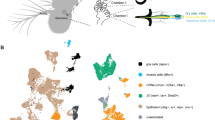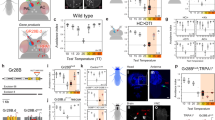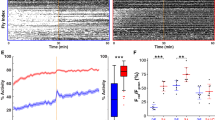Abstract
Although the ability to sense temperature is critical for many organisms, the underlying mechanisms are poorly understood. Using the calcium reporter yellow cameleon 2.1 and electrophysiological recordings, we identified thermosensitive neurons and examined their physiologic response in Drosophila melanogaster larvae. In the head, terminal sensory organ neurons showed increased activity in response to cooling by ≤1 °C, heating reduced their basal activity, and different units showed distinct response patterns. Neither cooling nor heating affected dorsal organ neurons. Body wall neurons showed a variety of distinct response patterns to both heating and cooling; the diverse thermal responses were strikingly similar to those described in mammals. These data establish a functional map of thermoresponsive neurons in Drosophila larvae and provide a foundation for understanding mechanisms of thermoreception in both insects and mammals.
This is a preview of subscription content, access via your institution
Access options
Subscribe to this journal
Receive 12 print issues and online access
$209.00 per year
only $17.42 per issue
Buy this article
- Purchase on Springer Link
- Instant access to full article PDF
Prices may be subject to local taxes which are calculated during checkout






Similar content being viewed by others
References
Bullock, T.H. & Diecke, F.P.J. Properties of an infra-red receptor. J. Physiol. 134, 47–87 (1956).
Hart, S. Beetle mania: an attraction to fire. BioScience 48, 3–5 (1998).
Schmitz, H. & Bleckmann, H. The photomechanic infrared receptor for the detection of forest fires in the beetle Melanophila acuminata (Coleoptera: Buprestidae). J. Comp. Physiol. [A] 182, 647–657 (1998).
Martin, J.H. & Jessell, T.M. Modality coding in the somatic sensory system. in Principles of Neural Science (eds. Kandel, E.R., Schwartz, J.H. & Jessell, T.M.) 341–352 (Elsevier Science Ltd., New York, 1991).
Campbell, A.L., Naik, R.R., Sowards, L. & Stone, M.O. Biological infrared imaging and sensing. Micron 33, 211–225 (2002).
Sayeed, O. & Benzer, S. Behavioral genetics of thermosensation and hygrosensation in Drosophila. Proc. Natl. Acad. Sci. USA 93, 6079–6084 (1996).
Brewster, R. & Bodmer, R. Origin and specification of type II sensory neurons in Drosophilia. Development 121, 2923–2936 (1995).
Grueber, W.B., Jan, L.Y. & Jan, Y.N. Tiling of the Drosophila epidermis by multidendritic sensory neurons. Development 129, 2867–2878 (2002).
Miyawaki, A., Griesbeck, O., Heim, R. & Tsien, R.Y. Dynamic and quantitative Ca2+ measurements using improved cameleons. Proc. Natl. Acad. Sci. USA 96, 2135–2140 (1999).
Miyawaki, A. et al. Fluorescent indicators for Ca2+ based on green fluorescent proteins and calmodulin. Nature 388, 882–887 (1997).
Kerr, R. et al. Optical imaging of calcium transients in neurons and pharyngeal muscle of C. elegans. Neuron 26, 583–594 (2000).
Python, F. & Stocker, R.F. Adult-like complexity of the larval antennal lobe of D. melanogaster despite markedly low numbers of odorant receptor neurons. J. Comp. Neurol. 445, 374–387 (2002).
Campero, M., Serra, J., Bostock, H. & Ochoa, J.L. Slowly conducting afferents activated by innocuous low temperature in human skin. J. Physiol. 535, 855–865 (2001).
Dykes, R.W. Coding of steady and transient temperatures by cutaneous 'cold' fibers serving the hand of monkeys. Brain Res. 98, 485–500 (1975).
Kenshalo, D.R. & Duclaux, R. Response characteristics of cutaneous cold receptors in the monkey. J. Neurophysiol. 40, 319–332 (1977).
Long, R.R. Sensitivity of cutaneous cold fibers to noxious heat: paradoxical cold discharge. J. Neurophysiol. 40, 489–502 (1977).
Heimbeck, G., Bugnon, V., Gendre, N., Haberlin, C. & Stocker, R.F. Smell and taste perception in Drosophila melanogaster larva: toxin expression studies in chemosensory neurons. J. Neurosci. 19, 6599–6609 (1999).
Sweeney, S.T., Broadie, K., Keane, J., Niemann, H. & O'Kane, C.J. Targeted expression of tetanus toxin light chain in Drosophila specifically eliminates synaptic transmission and causes behavioral defects. Neuron 14, 341–351 (1995).
Opplinger, F.Y., Guerin, P.M. & Vlimant, M. Neurophysiological and behavioural evidence for an olfactory function for the dorsal organ and a gustatory one for the terminal organ in Drosophila melanogaster larvae. J. Insect Physiol. 46, 135–144 (2000).
Darian-Smith, I., Johnson, K.O. & Dykes, R. 'Cold' fiber population innervating palmar and digital skin of the monkey: responses to cooling pulses. J. Neurophysiol. 36, 325–346 (1973).
Iggo, A. Cutaneous thermoreceptors in primates and sub-primates. J. Physiol. 200, 403–430 (1969).
Viana, F., de la Pena, E. & Belmonte, C. Specificity of cold thermotransduction is determined by differential ionic channel expression. Nat. Neurosci. 5, 254–260 (2002).
Susser, E., Sprecher, E. & Yarnitsky, D. Paradoxical heat sensation in healthy subjects: peripherally conducted by A delta or C fibres? Brain 122, 239–246 (1999).
Caterina, M.J. & Julius, D. The vanilloid receptor: a molecular gateway to the pain pathway. Annu. Rev. Neurosci. 24, 487–517 (2001).
Brand, A.H. & Perrimon, N. Targeted gene expression as a means of altering cell fates and generating dominant phenotypes. Development 118, 401–415 (1993).
Rubin, G.M. et al. Germ line specificity of P-element transposition and some novel patterns of expression of transduced copies of the white gene. Cold Spring Harb. Symp. Quant. Biol. 50, 329–335 (1985).
Wu, C.F., Suzuki, N. & Poo, M.M. Dissociated neurons from normal and mutant Drosophila larval central nervous system in cell culture. J. Neurosci. 3, 1888–1899 (1983).
Grynkiewicz, G., Poenie, M. & Tsien, R.Y. A new generation of Ca2+ indicators with greatly improved fluorescence properties. J. Biol. Chem. 260, 3440–3450 (1985).
Stewart, B.A., Atwood, H.L., Renger, J.J., Wang, J. & Wu, C.F. Improved stability of Drosophila larval neuromuscular preparations in haemolymph-like physiological solutions. J. Comp. Physiol. [A] 175, 179–191 (1994).
Acknowledgements
We thank T. Mayhew for assistance, L.L. Wallrath for fly stocks and facility and L.B. Solly for assistance in measuring larval locomotion. We also thank the DNA Core of the Diabetes and Endocrine Research Center (DK25295). This work was supported by the Howard Hughes Medical Institute and the National Institutes of Health (HL14388). M.J.W. is an Investigator of the Howard Hughes Medical Institute.
Author information
Authors and Affiliations
Corresponding author
Ethics declarations
Competing interests
The authors declare no competing financial interests.
Rights and permissions
About this article
Cite this article
Liu, L., Yermolaieva, O., Johnson, W. et al. Identification and function of thermosensory neurons in Drosophila larvae. Nat Neurosci 6, 267–273 (2003). https://doi.org/10.1038/nn1009
Received:
Accepted:
Published:
Issue Date:
DOI: https://doi.org/10.1038/nn1009
This article is cited by
-
Interspecies variation of larval locomotion kinematics in the genus Drosophila and its relation to habitat temperature
BMC Biology (2021)
-
Temperature synchronization of the Drosophila circadian clock protein PERIOD is controlled by the TRPA channel PYREXIA
Communications Biology (2019)
-
Feeling Hot and Cold: Thermal Sensation in Drosophila
Neuroscience Bulletin (2017)
-
A simple approach for measuring FRET in fluorescent biosensors using two-photon microscopy
Nature Protocols (2016)
-
Cold-sensing regulates Drosophila growth through insulin-producing cells
Nature Communications (2015)



